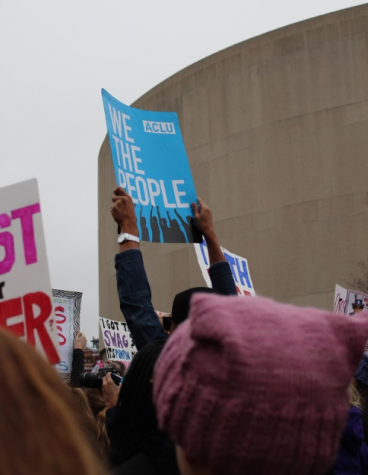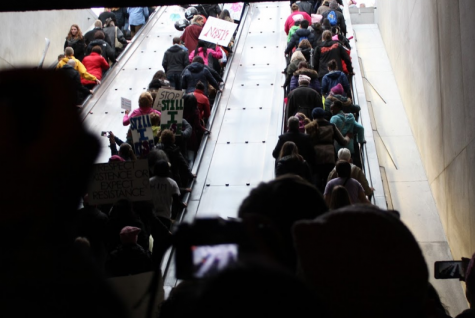Women’s March inspires students, teachers to join the Washington protest
After the inauguration of Donald Trump and the crowd of inauguration watchers cleared out, the streets of Washington D.C. filled with a different kind of crowd. An estimated 500,000 people, many wearing pink hats with pussy cat ears, marched the streets of Washington D.C. as part of the Women’s March on Washington.
Matticks marches with her mother

“As I meandered among the masses down Independence Ave, past the Washington Monument I made a point of reaching out to shake the hands of women who don’t look like me or held signs with different messages than my own,” Seibel-Hunt said.
“After we heard that Trump was the president elect officially and my mom had seen the Facebook group, we booked flights for me and my mom,” senior Ella Matticks said.
The march was loud, passionate and full of people celebrating women.
“The day of the march, we took a metro into the city, and the trains were jam-packed with people singing, and dancing and playing music on speakers,” Matticks said.
Seibel-Hunt travelled to D.C. to share truths
Upper School science teacher Beth Seibel-Hunt also traveled out to Washington to join the protest.
“The [Women’s] March in Washington was amazing. So many people in one place peacefully expressing their truths,” she said.
Marchers took to the streets with signs, some of them clever, some of them heartfelt, some of them serious.
“My sign had multiple panels. ‘I march 4 our unalienable rights’ ‘We are all created = ‘ , ‘Be Honest’,” Seibel-Hunt said.
“I feel we have so much work to do empowering each other, respecting each other and listening to each other’s truths, ” she said.
Although peaceful, march still brought controversy

“The day of the march, we took a metro into the city, and the trains were jam-packed with people singing, and dancing and playing music on speakers,” Matticks said.
The march did cause some controversy around who the march was really for: women, or just white feminists?
“I know there was a lot of controversy over the movement, because people were afraid it was going to be very centered around white feminism and people were going to ignore other female issues. But the organization did a really really good job of making it really intersectional and making a lot of very different voices heard,” Matticks said.
Seibel-Hunt also recognized that the people she was marching with all came from different backgrounds and experiences. She decided to approach the difference not as a road block, but as a one more reason to march.
“As I meandered among the masses down Independence Ave., past the Washington Monument, I made a point of reaching out to shake the hands of women who don’t look like me or held signs with different messages than my own. My line was, ‘Thank you for being here. I am proud to march with you’,” Seibel-Hunt said.
Although marchers all came from different backgrounds and experiences, they all had one thing in common: they wanted change.
“[The march] pulled a lot of different types of people from the community [to the march]. There were men, there were women of different color, there were men of different color, there were children of different ages, there were people with different sexual orientations. It was a very diverse group of people, which is important in the movement because we want to be intersectional feminists and not only attacking one set of principles,” Matticks said.
Marching taught lessons, with more to come
Matticks realizes the luck she has to be in her position, but she has decided to use that as a way to stand up for others who maybe aren’t in her same position.
“I’m very privileged to only feel like my rights are threatened in 2016, when other people have felt like there rights are under attack for their whole entire lives. Personally, I want to make sure that doesn’t happen again for other people. I want to be there for a bigger community that strives for equality,” Matticks said.
The Women’s March was started by a single women’s post on Facebook, in protest of Trump’s election, then spread like wildfire. Sister marches were planned in nearly 675 cities nationwide, with marcher numbers exceeding 4 million. Post march activism is encouraged through the Women’s March on Washington website, 10 actions/100 days.